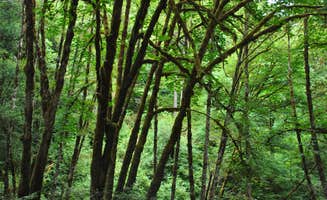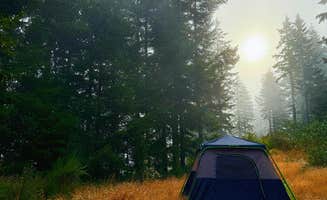Primitive camping near Gardiner, Oregon includes several secluded sites scattered across public lands where elevations range from 500 to 3,500 feet. The coastal influence creates year-round moisture with average rainfall exceeding 70 inches annually, particularly from November through April. Most dispersed sites remain accessible from May through October when forest roads dry out sufficiently for safer travel.
What to do
Waterfall hiking: Kentucky Falls Road offers access to several undeveloped campsites near trailheads leading to cascading falls. "Great spot! Quiet and if you walk a little over through a trail you'll get an amazing view of the sunset," notes one BLM Kentucky Falls Road camper. The road is "paved most of the way up," making it more accessible than some other forest routes.
Kayaking: Hult Pond provides a small body of water ideal for paddling near backcountry campsites. A visitor to Hult Pond reported, "The pond was great for kayaking and there is plenty to explore if you aren't worried about a little elevation in your hike." No motorized boats are permitted, maintaining the quiet atmosphere.
Forest exploration: Extensive logging roads throughout Elliott State Forest create access to remote camping areas. "The Elliott State Forest has more than 550 miles of roads and trails, but only a primary network has been maintained over the past 10 years," explains a reviewer, noting these roads lead to "excellent camping sites, including old lookouts, fishing holes, secluded springs."
What campers like
Ridge-top views: Several campers noted finding clearings with expansive vistas after driving forest roads. At Elliott State Forest Dispersed, one visitor shared: "Followed Marlow Creek road about 7 or 8 miles straight back until we reached the top of a hill. Cleared out from what looks to be trees that burned from a fire. Makes for amazing views."
Quiet seclusion: For those seeking isolation, deeper forest routes often lead to empty sites. "We drove back in a few miles and camped along the road, in some old growth forest. It was dark, and I mean truly dark in there when you shut off your lights off, and silent as a tomb. Huge uncut trees, bad ass country!" described a camper at Suislaw National Forest Dispersed Camping.
Creek-side spots: Multiple camping areas feature water access. According to one camper, "We found an awesome spot along Marlow Creek Road, about 4 miles into the forest. There are plenty of pull outs all along the way, with room for 2-3 cars. The road follows a babbling creek which was amazing to sleep next to."
What you should know
Download offline maps: Cell service disappears completely in most areas. One camper at Hult Pond warns: "We lost cell service about an hour before we even got there, and didn't have any the whole time there." Another visitor recommends: "There was surprisingly multiple spots that I had cell service (AT&T) so I was able to navigate myself around through a satellite map."
Road conditions vary seasonally: Summer access improves significantly. A visitor to Forest Road 55 Pulloff cautions: "Not a good idea to attempt in inclement or muddy weather due to exposed road along some stunning stretches high above the forest."
Trash management: No services exist at primitive sites. "Unfortunately, those before us left a lot of trash. Did my best to clean up when was left behind," reports one camper. Another notes they found "beautiful spots aside from the trash that was unfortunately scattered in several sites."
Tips for camping with families
Site selection timing: Arrive early to secure the best spots. A visitor to Doolittle Butte shares: "Beautiful stop for dispersed camping, someone built benches. Lot's of space for big group with multiple cars." Weekday arrivals offer better chances at premium locations.
Weather preparation: Temperature swings can be substantial. "We went during my spring break and I was lucky that it was too cold for most people to camp there," notes one camper who enjoyed extra privacy during cooler months. Rain gear remains essential year-round.
Wildlife awareness: Animal encounters occur regularly. One camper reported: "We had a visitor come sniff around but quickly left." Another mentions the "9pm daily goose choir" at Hult Pond. Keep food secure and pets leashed.
Tips from RVers
Vehicle limitations: Many forest roads aren't suitable for larger rigs. At Near Fawn Creek Campground, one visitor advised: "Very nice and secluded," though accessibility depends on your specific vehicle. Carefully research routes before attempting with RVs over 25 feet.
Grade challenges: Several campers report transmission issues on steep forest roads. Consider vehicle capabilities when planning routes, as some areas require AWD or 4x4. "Excellent spot up 2 steep inclines. Some of the most beautiful views. Good fire ring. Do not attempt if wet," warns one Suislaw National Forest camper.
Campsite sizes: Limited level areas exist for larger vehicles. A camper with a 38-foot RV cautions: "We got stuck in a ditch. RV almost tipped over trying to u-turn. If you go down the main lower path you will find an area big enough to u-turn! Don't do it until then!"




